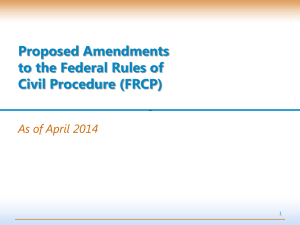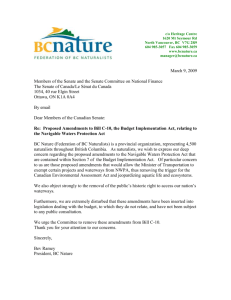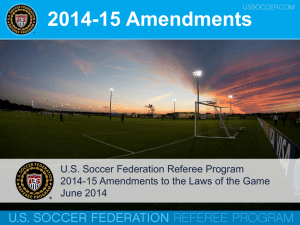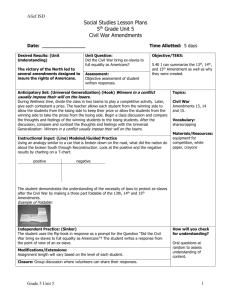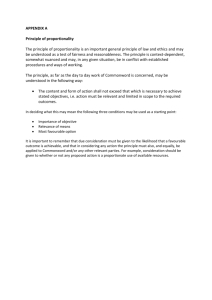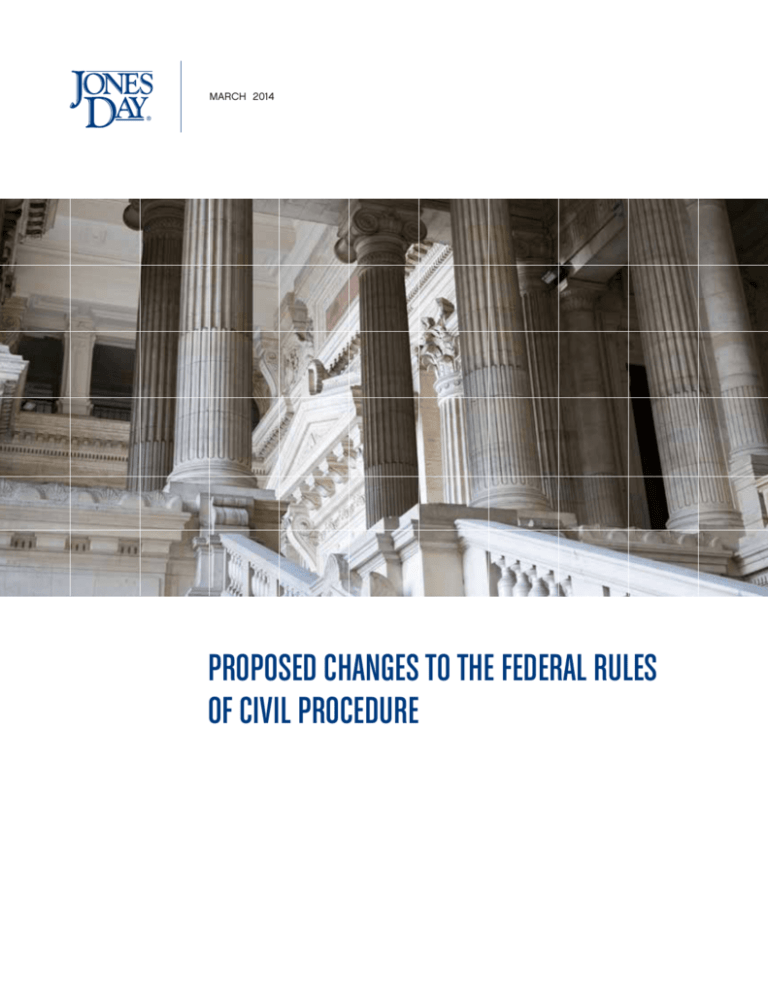
MARCH 2014
Proposed Changes to the Federal Rules
of Civil Procedure
On August 15, 2013, the Judicial Conference’s Advisory Com-
120 days to 60 days. If service has not occurred at that point,
mittee on Civil Rules (“Advisory Committee”) proposed
the judge may dismiss the action.
amendments to the Federal Rules of Civil Procedure
(“FRCP”). 1 The amendments included changes to several
After service, at the subsequent scheduling conference,
of the Rules, 2 with the most significant changes to Rules
proposed Rule 16(b)(1) would require “direct simultaneous
26 and 37.3 These changes, which the Advisory Committee
communication” 8 between parties, whether in person, by
first explored at a May 2010 conference at the Duke Univer-
telephone, or other sophisticated electronic means. The
sity School of Law (“Duke Conference”), 4 are arguably the
Advisory Committee believes these methods will create
most significant modifications to discovery since the 1993
a more effective scheduling conference because they do
amendments requiring initial disclosures. From May 2010
not involve the inherent time delays of the mail and other
to April 2013, the Advisory Committee developed the pro-
means.9 Proposed Rule 16(b)(2) requires the judge to issue
posed changes, which are designed to reach the goal of the
the scheduling order 90 days after any defendant has
FRCP—”[securing] the just, speedy, and inexpensive determi-
been served or 60 days after any defendant has appeared,
nation of every action and proceeding.”5 These amendments
whichever is earlier. This is reduced from the current 120
realize this goal by expediting the initial stages of each mat-
and 90 days, respectively. 10 Proposed Rule 16(b)(3)(B)(v)
ter, ensuring that discovery is proportional and limited to the
also states that the scheduling order may require a discov-
claims and defenses at issue in the litigation, and providing
ery conference with the court before a party may move for
that parties are not subjected to unnecessary costs related
a discovery order. The Advisory Committee Notes (“Notes”)
to an overly broad scope of discovery or document preserva-
indicate that judges who have held such conferences often
tion obligations.
find them to be an efficient way to speedily and efficiently
resolve discovery disputes.11
The amendments were open to public comment from August
15, 2013 to February 18, 2014.6 The more than 2,300 comments
Proposed Rule 26(d)(1) clarifies the occasions on which par-
submitted run the gamut from enthusiastically welcoming the
ties may seek discovery prior to the Rule 26(f) conference
changes as essential to sharply criticizing them as unneces-
by specifying that Rule 26(d)(2) is among the exceptions
sary and unfair. Commenters on both sides suggested fur-
generally authorized by the rules. Rather than allowing par-
ther changes. Several bodies must now consider the rules
ties to file a motion to modify the sequence of discovery,
and these related comments. This White Paper describes the
as the original Rule 26(d)(2) permits, the newly renumbered
proposed changes, provides an overview of the comments
Rule 26(d)(3) allows parties to stipulate to case-specific
submitted, and outlines the next steps in the process.7
sequences of discovery.
Privilege and Preservation
PROPOSED AMENDMENTS
Given that the Rule 26(f) conference “kicks off” discovery, the
The proposed amendments focus on three issues: early case
proposed changes allow parties to identify issues in advance
management, proportionality, and preservation. The early
and to address them more substantively at the conference.
case management changes expedite the earliest stages of
Rule 16(b)(3)(B)(iii) and Rule 26(f)(3)(C) discuss document
litigation, while the proportionality proposals reconcile dis-
preservation. Proposed Rule 16 states that a scheduling order
covery’s scale and scope to the matter’s specific needs in an
may also address the preservation of electronically stored
information (“ESI”). Proposed Rule 26 states that the discovery plan must include the parties’ views and proposals on the
preservation of ESI. These changes are made with the recognition “that a duty to preserve discoverable information may
arise before an action is filed.”12
effort to cabin related costs. Finally, the preservation changes
encourage litigants to preserve discoverable information
while resolving the substantial jurisdictional differences of
overpreservation-related sanctions. In so doing, the changes
reduce unnecessary costs and burdens associated with overpreservation or spoliation that is not willful or in bad faith.
Additional changes to Rule 16(b)(3)(B)(iv) and Rule 26(f)(3)(D)
address privilege. Proposed Rule 16 states that a scheduling
EARLY CASE MANAGEMENT
order may include agreements reached under Federal Rule
of Evidence (“FRE”) 502,13 and proposed Rule 26 states that
Scheduling
the discovery plan must state the parties’ views and propos-
Many of the proposed scheduling changes aim to reduce
als on claims of privilege, including whether to ask the court
the delay at the beginning of litigation. Proposed Rule 4(m)
to include an order under FRE 502.
decreases the time period for serving a defendant from
2
Document Productions
This amendment recognizes that while some adversarial
behavior is essential for the litigation process, parties must
Proposed Rule 26(c)(1)(B) explicitly recognizes the court’s
balance the adversarial nature with notions of cooperation.
power to enter a protective order allocating the expenses of
“Effective advocacy,” the Notes state, “is consistent with —
discovery. Although judges have this authority under the cur-
and indeed depends upon — cooperative and proportional
rent rules, the goal of the change is to prevent parties from
use of procedure.” 18 Cooperation is not mandatory here.
contesting that authority.14
Although the Advisory Committee considered making cooperation mandatory, it was concerned that such a mandate
Proposed Rule 26(d)(2) permits a party to serve Rule 34
would spark additional litigation on whether the parties were
document requests prior to a Rule 26(f) conference, but no
being appropriately cooperative.19
earlier than 21 days after the receiving party was served in
the litigation. The requests will be deemed served as of the
The Committee proposes a wholesale change to Rule 26(b)(1).
Rule 26(f) conference, with the response deadline still run-
The proposal limits the scope of discovery to that which is “pro-
ning from that conference date. This is in contrast to the cur-
portional to the needs of the case,” and it provides five illus-
rent rule, which forbids serving any requests for production
trative factors for courts to consider. This language completely
prior to the Rule 26(f) conference. This change is among the
replaces the current, and often quoted, “reasonably calculated
changes intended to encourage the parties to have a more
to lead to the discovery of admissible evidence” language,
informed, focused conversation at the conference.15
which the Advisory Committee believes courts often interpret
too broadly.20 The rule also narrows relevant matter to “any par-
A party’s response to requests for production, under pro-
ty’s claim or defense” rather than the “subject matter involved
posed Rule 34(b)(2)(B) and (C), must state the grounds for
in the action.” These changes will alter the rule as shown below.
the objection with specificity, must indicate if documents will
be withheld on the basis of the stated objections, and must
Rule 26(b)(1)—Scope of Discovery (emphasis added)
include a reasonable date for production (otherwise production must occur on the timeline of the requesting party).16 The
Current Rule 26(b)(1)
Notes recognize that some cases require a rolling production;
Scope in General. Unless otherwise limited by court
those responses should specify the start and end dates of
order, the scope of discovery is as follows: Parties may
production.17 Lastly, Rule 37(a)(3)(B)(iv)’s amendment permits
obtain discovery regarding any nonprivileged mat-
a party to move for an order to compel production if another
ter that is relevant to any party’s claim or defense—
party fails to produce documents, which takes into account
including the existence, description, nature, custody,
the common practice to produce copies of documents rather
condition, and location of any documents or other tan-
than make documents available for inspection.
gible things and the identity and location of persons
who know of any discoverable matter. For good cause,
the court may order discovery of any matter relevant to
PROPORTIONALITY
the subject matter involved in the action. Relevant infor-
In an effort to limit the ever-increasing costs of litigation to
covery appears reasonably calculated to lead to the
those costs that are necessary for the “just, speedy, and
discovery of admissible evidence. All discovery is sub-
inexpensive determination of every action and proceeding,”
ject to the limitations imposed by Rule 26(b)(2)(C).
mation need not be admissible at the trial if the dis-
the Advisory Committee proposes many changes to narrow the scope of discovery. These changes, often referred
Proposed Rule 26(b)(1)
to as the “proportionality changes,” begin with Rule 1. The
Scope in General. Unless otherwise limited by court
proposed Rule 1 change amends the second sentence as
order, the scope of discovery is as follows: Parties
shown in red below.
may obtain discover y regarding any nonprivileged matter that is relevant to any party’s claim or
Rule 1 – Scope and Purpose
defense and proportional to the needs of the case,
RULE 1—SCOPE AND PURPOSE
considering the amount in controversy, the impor-
These rules govern the procedure in all civil actions
tance of the issues at stake in the action, the parties’
and proceedings in the United States district courts,
resources, the importance of the discovery in resolv-
except as stated in Rule 81. They should be construed,
ing the issues, and whether the burden or expense of
and administered, and employed by the court and the
the proposed discovery outweighs its likely benefit.
parties to secure the just, speedy, and inexpensive
Information within this scope of discovery need not
determination of every action and proceeding.
be admissible in evidence to be discoverable.
3
Rule 37(E)(1)—Failure to Preserve Discoverable
Information (emphasis added)
Proposed Rule 26(b)(2) provides largely logistical updates,
adding requests for admission to the list of requests that Rule
30 may limit. It eliminates the option for a court to use Rule 36
Current Rule 37(e)
to limit requests by order or local rule in subsection A, simpli-
Failure to Provide Electronically Stored Information.
fies when a court is required to limit the frequency or extent of
Absent exceptional circumstances, a court may not
discovery in subsection C, and encourages the court to use
impose sanctions under these rules on a party for fail-
the revised Rule 26(b)(1) to make that discovery determina-
ing to provide electronically stored information lost as
tion (rather than benefit/burden analysis) in subsection C(iii).
a result of the routine, good-faith operation of an elec-
Rule 34(b)(2)(A) similarly concerns logistics, requiring a party
tronic information system.
to respond to a request for production delivered under Rule
26(d)(2) within 30 days after the first Rule 26(f) conference.
Proposed Rule 37(e)(1)
Failure to Preserve Discoverable Information. (1) Cura-
Amendments to Rules 30, 31, 33, and 36 provide new, specific
tive measures; sanctions. If a party failed to pre-
limits on discovery tools based on empirical research by the
serve discoverable information that should have been
Federal Judicial Center.21
PROPOSED LIMITS FOR DISCOVERY TOOLS
Discovery Tool
Additional requests with
Current Limit
Proposed Limit
10 depositions per party
5 depositions per party
yes
7 hours each
6 hours each
yes
25
15
yes
None
25
yes
permission of the court?
Depositions (R. 30 and 31)
Interrogatories (R. 33)
Requests for Admission (R.36)
(other than authenticity)
The court may grant additional requests for these discovery
preserved in the anticipation or conduct of litigation,
rules to the extent Rules 26(b)(1)–(2) require. While the pro-
the court may:
posed limitations are more conservative than the current
(A) permit additional discovery, order curative mea-
limits, they merely represent a starting point for negotiations
sures, or order the party to pay the reasonable
with the court. Collectively, the proposed amendments also
expenses, including attorney’s fees, caused by the
encourage litigants to think both offensively and defensively
failure; and
about using discovery tools. For instance, a party should con-
(B) impose any sanction listed in Rule 37(b)(2)(A) or
sider that listing boilerplate affirmative defenses may provide
give an adverse-inference jury instruction, but only if
another party with sound reason to argue for a higher num-
the court finds that the party’s actions:
(i) caused substantial prejudice in the litigation and
ber of discovery requests.
were willful or in bad faith; or
(ii) irreparably deprived a party of any meaningful
PRESERVATION
opportunity to present or defend against the claims
in the litigation.
The final category is the changes designed to address preservation of documents and other information. These changes,
Proposed Rule 37(e)(1) provides “curative measures” and
which overlap with the new focus on proportionality and include
“sanctions” should a party fail to preserve discoverable infor-
the revisions to Rule 26 discussed above, are otherwise within
mation in anticipation of litigation. In so doing, the proposed
proposed Rule 37. Proposed Rule 37(e)(1) rewrites the current
rule limits “sanctions” to destruction (versus loss) of discover-
rule completely. The Notes explicitly state that this was, in part,
able information. The curative measures listed in Rule 37(e)
to address disparate expectations across the federal circuit
(1)(A) are available where the harm of loss can be substan-
courts and the fact that “[e]xtremely expensive overpreservation
tially undone or a party took reasonable steps to preserve. In
may seem necessary due to the risk that very serious sanctions
contrast, the sanctions listed in Rule 37(e)(1)(B) require “sub-
could be imposed even for merely negligent, inadvertent failure
stantial prejudice” and “willfulness or bad faith” or that a party
to preserve some information later sought in discovery.”22
4
was “irreparably deprived” of “any meaningful opportunity”
Former Senator Jon Kyl (R–AZ), who served as a member of
to present or defend against claims in the litigation. Accord-
the Senate Judiciary Committee, also submitted a comment.
ingly, these changes remove the stigma associated with
sanctions and remove the routine threat of sanctions where
These commenters typically celebrated the Advisory Com-
conduct does not warrant them.
mittee’s effort to integrate a proportionality consideration
into discovery and to encourage efficiency and fairness. The
While the newly proposed Rule 37(e)(2) allows the court to
Sedona Conference supported the deletion of “reasonably
consider “all relevant factors” to assess a party’s conduct,
calculated to lead to the discovery of admissible evidence”
it provides five factors to guide a court’s analysis. A court
from Rule 26(b)(1) as a means to “help cabin excessive dis-
should examine (i) the extent to which a party was on notice
covery.”25 Another commenter suggested adding language to
that litigation would likely occur and that the information
this rule that would encourage technology-assisted review as
would be discoverable, (ii) the reasonableness of the par-
means of complying with proportionality requirements.26 Sen-
ty’s effort to preserve the information, (iii) whether the party
ator Kyl and Professor Donald Elliott coauthored a comment
received a reasonable, clear request to preserve information
noting the upward trend in litigation costs and the use of dis-
(as well as whether the parties consulted in good faith about
covery as a “bludgeon for settlement” rather than a search
the scope of preservation for the request), (iv) the proportion-
for truth. They argued that the proportionality standard was
ality of the preservation efforts to any anticipated or ongoing
not new, but its prominent placement in Rule 26(b)(1) would
litigation, and (v) whether the party timely sought the court’s
require parties to take it more seriously.27
guidance on any unresolved disputes about preserving discoverable information. Using these factors, a court can deter-
These commenters similarly championed the propos-
mine if a situation warrants curative measures, sanctions, or
als’ efforts to deter overpreservation and promote a uniform
no remedy at all for a loss of discoverable information.
standard for spoliation in Rule 37(e). Many argue that the
standard for sanctions under Rule 37 should be limited to
The first of these Rule 37(e)(2) factors (a party being on
circumstances involving willfulness and bad faith. The New
notice about litigation) mirrors the common law standard,
York State Bar Association seemingly suggests that the rules
that the duty to preserve arises when a party knew or reason-
should take something of a middle ground between the cur-
ably should have known about litigation. Any loss occurring
rent rule and the proposed change. It suggests that Rule 37(e)
before that triggering moment does not warrant sanctions
(1) should impose a rebuttable presumption of substantial prej-
or other curative measures. These factors should help par-
udice against a party who acts willfully or in bad faith; the rules
ties comply with the common law standard, allow the court to
define “willfulness” as unreasonable conduct, either intentional
determine when the duty to preserve arose, and decide what
or reckless, that will likely create harm; and that “[a]ctions”
information warranted preservation. Finally, because this list
should include an omission in action.28 The Sedona Confer-
is not exhaustive, a party’s failure to meet any one factor
ence also recommended a more unified approach to cura-
does not mean his actions were willful or in bad faith. As the
tive measures and sanctions as well as a “good faith” standard
Notes state, “[Rule 37(e)] does not provide ‘bright line’ preser-
instead of a “bad faith” standard.29 The U.S. Department of
vation directives because bright lines seem unsuited to a set
Justice made a more cautious endorsement of the proposed
of problems that is intensely context-specific.”23
rules, particularly the proportionality standard. It expressed
reservations about the proposed acceleration of the scheduling order as well as the numerical limits on discovery tools.30
OVERVIEW OF PUBLIC COMMENTS
Comments that Generally Opposed the Proposed
Amendments
Attorneys, judges, professors, corporations, law firms, and
public interest and professional organizations submitted
The majority of the comments expressed general opposition
more than 2,300 comments on the proposed rules during the
to the proposed amendments. These commenters included
six-month public comment period.24 The comments generally
individual plaintiffs’ attorneys, related trade associations, and
expressed either support or opposition to the rules and often
various affiliates of the American Association for Justice. The
recommended additional changes.
Honorable Shira Scheindlin of the Southern District of New
Comments that Generally Supported the Proposed
Amendments
York, a notable electronic discovery expert, also submitted
The commenters in support of the proposed amendments
These commenters were deeply concerned about the pro-
comments narrowly on the changes she opposed.
included Fortune 500 corporations, large law firms, the Duke
posed amendments to Rules 30, 31, 33, and 36, regard-
Law Center for Judicial Studies, and the Sedona Conference.
ing limits to various discovery requests. They regarded the
5
requests as essential to litigation’s natural fact-finding pro-
on or before May 1, 2015. Any such rules would take effect
cess and maintained that parties can reasonably manage
on December 1, 2015, unless Congress enacts legislation
this process
themselves.31
to reject, modify, or defer them. As a result, the earliest any
These comments also raised three
changes could take effect is December 1, 2015.
primary objections to Rule 26(b)(1)’s proposed proportionality
standard. First, they considered the change to be unnecessary since the current process fairly apportions the costs and
CONCLUSION
benefits of discovery, disproportionate discovery is empirically uncommon, and current practice excuses a party from
The parties supporting or opposing the proposed rule
production where the burden outweighs the benefit. 32 Sec-
changes are exactly the ones you would have predicted
ond, they argued that the proportionality standard and its five
based on the goals set out at the Duke Conference. Plain-
enumerated factors will result in excessive motion practice
tiffs’ attorneys and trade organizations largely oppose the
as parties litigate the meaning of these terms in the context
of their
case. 33
changes, perceiving them as unnecessary and as stifling
Lastly, these commenters expressed con-
discovery’s fact-finding mission. Larger corporations and
cern that this new standard would treat plaintiffs unfairly by
the law firms that often represent them favor the amend-
imposing an additional hurdle (beyond the burden of proof)
on
them.34
ments, applauding them as a critical step in controlling the
Informational asymmetries require robust discov-
ery, they also
argued.35
ever-increasing cost of discovery. Such a juxtaposition indi-
Judge Scheindlin similarly argued the
cates that the rules and the rule amendments are doing
proportionality standard was unnecessary, since parties usu-
precisely what they were intended to do, which is rein in dis-
ally amicably agree to what information is relevant, and the
covery costs and return the focus of litigation to the parties’
standard did not state which party bears the burden to demonstrate
claims and defenses. As a result, while we expect comments
proportionality.36
to result in some changes to the proposed rules, wholesale
changes seem unlikely.
Many amendments to Rule 37(e) troubled these commenters.
They complained that the new sanctions standard would
allow defendants to escape accountability since “willfulness
LAWYER CONTACTS
or bad faith” imposes a higher threshold for destruction than
the current good faith standard.37 Another commenter ques-
For further information, please contact your principal Firm
tioned if the proposals violated the Rules Enabling Act, since
representative or one of the lawyers listed below. General
the addition of a willfulness finding and proportionality stan-
email messages may be sent using our “Contact Us” form,
dard to the Rule might alter the substantive right to sanctions
which can be found at www.jonesday.com.
and violate established case law. 38 The preservation rules,
these commenters concluded, would only create more problems than they solved.
NEXT STEPS
Joshua L. Fuchs
David S. Rutkowski
Houston
San Francisco / Silicon Valley
+1.832.239.3719
+1.415.875.5797
jlfuchs@jonesday.com
+1.650.687.4152
dsrutkowski@jonesday.com
The proposed amendments represent the culmination of
years of hard work, yet many months of work remain. The
Christopher Lovrien
Advisory Committee is presently reviewing the comments
Los Angeles
and hearing testimony. It will likely spend two to four months
+1.213.243.2316
deciding if and how to further revise the rules before com-
cjlovrien@jonesday.com
municating proposed changes to the Judicial Conference’s
Committee on Rules of Practice and Procedure (“Standing
John M. Majoras
Committee”). At the earliest, the Standing Committee would
Columbus / Washington
consider the changes during its June 2014 meeting. The
+1.614.281.3835
Standing Committee may then recommend the rule changes
+1.202.879.7652
to the Judicial Conference, the policymaking body of the fed-
jmmajoras@jonesday.com
eral courts. The Judicial Conference is scheduled to meet in
September 2014, where it could recommend changes to the
Carmen G. McLean
U.S. Supreme Court, which has the authority to promulgate
Washington
the FRCP under the Rules Enabling Act of 1934. The Supreme
+1.202.879.3744
Court could then consider and promulgate any revised rules
cgmclean@jonesday.com
6
APPENDIX A: PROPOSED AMENDMENTS TO THE FEDERAL RULES OF CIVIL PROCEDURE
Rule
Category
Proposed Amendment
1
Proportionality
Instructs courts and parties to use rules to secure just, speedy, inexpensive
litigation
4(m)
ECM – Scheduling
Reduces time limit for service to sixty days after complaint is filed
16(b)(1)
ECM – Scheduling
Requires direct, simultaneous communication at the scheduling conference
16(b)(2)
ECM – Scheduling
Reduces time period to issue scheduling order
16(b)(3)(B)(iii)
ECM – Privilege &
Preservation
Permits scheduling order to address preservation of ESI
16(b)(3)(B)(iv)
ECM – Privilege &
Preservation
Permits scheduling order to include agreements reached under FRE 502
16(b)(3)(B)(v)
ECM – Scheduling
Permits scheduling order to require conference before discovery order
26(b)(1)
Proportionality
Requires discovery to be proportional to needs of the case
26(b)(2)(A)
Proportionality
Adds requests for admission to list of discovery tools that may be limited;
eliminates option for court to use R. 36 to limit requests by order or local rule
26(b)(2)(C)
Proportionality
Simplifies when a court is required to limit frequency of discovery
26(b)(2)(C)(iii)
Proportionality
Encourages court to use R. 26(b)(1) to define discovery’s scope
26(c)(1)(B)
ECM – Documents
Permits courts to enter protective order allocating discovery expenses
26(d)(1)
ECM – Scheduling
Adds R. 26(d)(2) as exception to a party seeking discovery prior to R. 26(f)
conference
26(d)(2)
ECM – Documents
Permits R. 34 request to be sent prior to R. 26(f) conference; deemed served at
that conference
26(d)(3)
ECM – Scheduling
Permits parties to stipulate to sequence of discovery
26(f)(3)(C)
ECM – Privilege &
Preservation
Requires discovery plan to state parties’ views on ESI preservation
26(f)(3)(D)
ECM – Privilege &
Preservation
Requires discovery plan to state parties’ views on claims of privilege and whether
to ask court to include agreement in FRE 502 order
30(a)(2)(A)(i)
Proportionality
Requires court permission for >5 oral depositions per party
30(d)(1)
Proportionality
Requires court permission for deposition >6 hours
31(a)(2)(A)(i)
Proportionality
Requires court permission for >5 written depositions per party
33(a)(1)
Proportionality
Requires court permission for >15 interrogatories per party
34(b)(2)(A)
Proportionality
Requires party to respond to request for production delivered per R. 26(d)(2)
within 30 days after first R. 26(f) conference
34(b)(2)(B)
ECM – Documents
Requires parties to state objections with specificity; permits parties to state that
will produce rather than permit inspection; requires parties to include reasonable
date for production (or produce on timeline of requesting party)
34(b)(2)(C)
ECM – Documents
Requires parties to indicate if document will be withheld based on objections
36(a)(2)
Proportionality
Requires court permission for >25 requests for admission per party
37(a)(3)(B)(iv)
ECM – Documents
Permits motion to compel if party fails to produce documents
37(e)(1)
Preservation
Permits curative measures and sanctions for failure to preserve discoverable
information
37(e)(2)
Preservation
Provides nonexhaustive factors to determine if there was a failure to preserve, and
if it was willful or in bad faith
7
Endnotes
1
Committee on Rules of Practice and Procedure of the
Judicial Conference of the United States, Preliminary Draft of
Proposed Amendments to the Federal Rules of Bankruptcy
and Civil Procedure — Request for Comment (2013) [hereinafter Committee Report on Proposed Amendments], available at
http://www.uscourts.gov/uscourts/rules/preliminary-draft-proposed-amendments.pdf.
2 Namel, Rules 1, 4, 6, 16, 26, 30, 31, 33, 34, 36, 37, 55, and 84.
3This White Paper does not analyze proposed changes to the
Federal Rules of Bankruptcy Procedure or the Federal Rules
of Civil Procedure’s Appendix of Forms (Rule 84), the latter
of which the Advisory Committee recommended abrogating.
Proposed modifications to Rule 6(d) (Additional Time After
Kinds of Service) and Rule 55 (Setting Aside a Default or a
Default Judgment) are less germane to electronic discovery
and therefore excluded.
4 The conference sought to explore the current costs of civil
litigation, with particular emphasis on brainstorming solutions
to manage discovery costs. Relying on empirical research
done by the Federal Judicial Center, the Conference determined how satisfied litigants were with the present system.
It combined that empirical research with suggestions from
lawyers to determine how the FRCP could more closely align
with their stated goal.
5 Fed. R. Civ. P. 1.
6 This end date was an extension from the original February 15,
2014 deadline.
7 Appendix A provides a one-page summary of all proposed
changes discussed in this White Paper.
8 Committee Report on Proposed Amendments, supra note 1,
at 287.
9 Committee Report on Proposed Amendments, supra note 1,
at 262.
10 Should a judge find good cause for delay, he or she has discretion to extend these deadlines.
11 Committee Report on Proposed Amendments, supra note 1,
at 288.
12 Committee Report on Proposed Amendments, supra note 1,
at 287.
13 Both changes reference FRE 502 because that rule considers the inadvertent disclosure of privileged information or
attorney work product.
14 Committee Report on Proposed Amendments, supra note 1,
at 298.
15 See Committee Report on Proposed Amendments, supra
note 1, at 298.
16 Proposed Rule 34 permits the responding party to state that
it will produce copies of documents instead of permitting
inspection in recognition of the fact that this is the common
practice. See Committee Report on Proposed Amendments,
supra note 1, at 308–09.
17 Committee Report on Proposed Amendments, supra note 1,
at 309.
18 Committee Report on Proposed Amendments, supra note 1,
at 281.
19 Committee Report on Proposed Amendments, supra note 1,
at 270.
20 Committee Report on Proposed Amendments, supra note 1,
at 266.
21 Although the Advisory Committee considered adding a presumptive limit to RFPs, it ultimately decided not to do so.
Committee Report on Proposed Amendments, supra note 1,
at 267.
22 Committee Report on Proposed Amendments, supra note 1,
at 318.
23 Committee Report on Proposed Amendments, supra note 1,
at 318.
24 The Advisory Committee also held three hearings on the
proposed changes. They occurred in Washington, D.C.
(November 7, 2013), Phoenix, Arizona (January 9, 2014), and
Dallas, Texas (February 7, 2014).
25 Preliminary Draft of Proposed Amendments to the Federal
Rules of Civil Procedure, No. USC-RULES-CV-2013-0002, Cmt.
of The Sedona Conference, at 5 (Nov. 26, 2013) [hereinafter
Cmt. of The Sedona Conference].
26 Preliminary Draft of Proposed Amendments to the Federal
Rules of Civil Procedure, No. USC-RULES-CV-2013-0002, Cmt.
of Duke Law Center for Judicial Studies, at 1 (Oct. 17, 2013).
27 Preliminary Draft of Proposed Amendments to the Federal
Rules of Civil Procedure, No. USC-RULES-CV-2013-0002, Cmt.
by Hon. Jon Kyl and Prof. E. Donald Elliot, at 1–2, 3–4.
28 S e e P r e l i m i n a r y D r a f t o f P r o p o s e d A m e n d m e n t s
t o t h e F e d e r a l R u l e s o f C i v i l P r o c e du re , N o. U S C RULES-CV-2013-0002, Cmt. of N.Y. State Bar Ass’n, at 2 (Oct.
2, 2013).
29 See generally Cmt. of The Sedona Conference, supra note
25, at 8–20.
30 Preliminary Draft of Proposed Amendments to the Federal
Rules of Civil Procedure, No. USC-RULES-CV-2013-0002, Cmt.
of U.S. Dep’t of Justice, at 2 (Jan. 28, 2014).
31 See, e.g., Preliminary Draft of Proposed Amendments
t o t h e F e d e r a l R u l e s o f C i v i l P r o c e du re , N o. U S C RULES-CV-2013-0002, Cmt. of Elfvin & Besser (Feb. 13, 2013);
Cmt. of Highman, Highman & Ball (Feb. 21, 2013); Cmt. of The
Goldblatt Law Firm (Feb. 27, 2013).
32 Preliminary Draft of Proposed Amendments to the Federal
Rules of Civil Procedure, No. USC-RULES-CV-2013-0002,
Cmt. of Public Justice, at 6 (Mar. 1, 2013); Cmt. of Center for
Constitutional Litigation, at 3–6 (Mar. 1, 2013).
33 S e e P r e l i m i n a r y D r a f t o f P r o p o s e d A m e n d m e n t s
t o t h e F e d e r a l R u l e s o f C i v i l P r o c e du re , N o. U S C RULES-CV-2013-0002, Cmt. of Bay Area Employment Law
Office, at 3 (Feb. 28, 2013).
34 Preliminary Draft of Proposed Amendments to the Federal
Rules of Civil Procedure, No. USC-RULES-CV-2013-0002, Cmt.
of Am. Ass’n for Justice, at 24 (Dec. 19, 2013) [hereinafter Cmt.
of Am. Ass’n for Justice].
35 Preliminary Draft of Proposed Amendments to the Federal
Rules of Civil Procedure, No. USC-RULES-CV-2013-0002, Cmt.
of Andrus Anderson LLP, at 3–5 (Dec. 23, 2013).
36 S e e P r e l i m i n a r y D r a f t o f P r o p o s e d A m e n d m e n t s
t o t h e F e d e r a l R u l e s o f C i v i l P r o c e du re , N o. U S C RULES-CV-2013-0002, Cmt. by Judge Shira A. Scheindlin, at
2–4 (Jan. 13, 2014).
37 See Cmt. of Am. Ass’n for Justice, supra note 34, at 21–23.
38 S e e P r e l i m i n a r y D r a f t o f P r o p o s e d A m e n d m e n t s
t o t h e F e d e r a l R u l e s o f C i v i l P r o c e du re , N o. U S C RULES-CV-2013-0002, Cmt. by Ronald J. Hedges, at 2–6
(Aug. 20, 2013).
Jones Day publications should not be construed as legal advice on any specific facts or circumstances. The contents are intended for general
information purposes only and may not be quoted or referred to in any other publication or proceeding without the prior written consent of the
Firm, to be given or withheld at our discretion. To request reprint permission for any of our publications, please use our “Contact Us” form, which
can be found on our website at www.jonesday.com. The mailing of this publication is not intended to create, and receipt of it does not constitute,
an attorney-client relationship. The views set forth herein are the personal views of the authors and do not necessarily reflect those of the Firm.
© 2014 Jones Day. All rights reserved. Printed in the U.S.A.

